![は (wa) – Topic Marker and Contrast in Japanese [JLPT N5]](http://hirakan.com/cdn/shop/articles/wa-topic-marker.jpg?v=1761385996&width=1100)
は (wa) – Topic Marker and Contrast in Japanese [JLPT N5]
Aktie
Quick Summary
Meaning: Marks the topic of the sentence — what you’re talking about. Often feels like “as for...” in English; can also show contrast.
How to Use: Put は after the word or phrase you want to talk about, then make a comment about it.
Example:
- 月はチーズです。
- Tsuki wa chiizu desu.
- The moon is cheese.
Overview
In Japanese, は is the topic marker. It attaches to the part of the sentence you want to highlight as the main theme. Think of it as “as for X, ....” Once the topic is clear, Japanese often drops the topic in later sentences if it stays the same.
Important: When used as a particle, は is pronounced “wa”, not “ha.” It does not mean “is/are.” The polite “be” is です (desu, be), which usually comes at the end of the sentence.
Compared with the subject marker が, は is more about setting context (what we’re talking about) and can also signal contrast. For beginners, it’s enough to remember: use は to introduce what your sentence is about, and then say something about it.
Structure / Formation
Core Idea
Topic + は + Comment
You choose the topic (a noun, a time, a place, even a whole clause), attach は, and then make your statement.
Pronunciation
As a particle, は is read “wa.” The spelling is は, but you say “wa.”
Where は Goes
は follows the word or phrase that is the topic:
- Person は ...
- Time は ...
- Place は ...
- Noun (thing) は ...
Base Patterns
- N は comment
- Time は comment
- Place は comment
- Person は comment
- N1 は N2 です
- N は i-adj です
- N は na-adj です
- Clause は comment
- N は V
- N は V-ます
Mini Patterns Table
| Topic type | Pattern | Meaning idea |
|---|---|---|
| Person | Person は N2 です | As for Person, (they) are N2 |
| Time | Time は N/adj です | As for Time, (it is) N/adj |
| Place | Place は V | As for Place, (someone) does V |
| Thing | N は V-ます | As for N, (someone) does V |
Short Examples
- 祖父はアイドルです。
- Sofu wa aidoru desu.
- Grandpa is an idol.
- 私の猫は毎朝新聞を読みます。
- Watashi no neko wa maiasa shinbun o yomimasu.
- My cat reads the newspaper every morning.
- 夜は忍者です。
- Yoru wa ninja desu.
- At night, I am a ninja.
Usage Tips
- Start with は to set the scene. After you introduce a topic like 私 (watashi, I) or 今日 (kyou, today), you can often leave it out in the next sentences if it stays the same.
- Contrast with は. Using は on two different items can contrast them: “As for X..., as for Y...” (Detailed practice comes later; for now, feel the “as for” nuance.)
- は is not “be.” Use です (desu, be) for polite “is/are,” and verbs like 読みます (yomimasu, to read) for actions.
Example Sentences
- 先生はロボットです。
- SENSEI wa robotto desu.
- The teacher is a robot.
- 朝はおばけも早起きです。
- Asa wa obake mo hayaoki desu.
- In the morning, even ghosts wake up early.
- 火星ではピザが人気です。
- Kasei de wa piza ga ninki desu.
- On Mars, pizza is popular.
- 私の金魚は宿題を手伝います。
- Watashi no kingyo wa shukudai o tetsudaimasu.
- My goldfish helps with homework.
- コーヒーは好きですが、お茶は嫌いです。
- Koohii wa suki desu ga, ocha wa kirai desu.
- I like coffee, but I don’t like tea.
Quick Practice
(Answers and explanations are right under this section.)
Multiple-Choice
-
Choose the sentence that correctly uses は to set the topic “I.”
- A. 私がは雲を食べます。 (Watashi ga wa kumo o tabemasu.)
- B. 私は雲を食べます。 (Watashi wa kumo o tabemasu.)
- C. 私と雲を食べます。 (Watashi to kumo o tabemasu.)
- D. 私や雲を食べます。 (Watashi ya kumo o tabemasu.)
-
Mark “night” as the topic. Which sentence does this?
- A. 夜は冷蔵庫が歌います。 (Yoru wa reizouko ga utaimasu.)
- B. 夜に冷蔵庫が歌います。 (Yoru ni reizouko ga utaimasu.)
- C. 夜で冷蔵庫は歌います。 (Yoru de reizouko wa utaimasu.)
- D. 夜でも冷蔵庫が歌います。 (Yoru demo reizouko ga utaimasu.)
-
Which sentence clearly shows contrast using は?
- A. コーヒーは好きですが、お茶は好きじゃないです。 (Koohii wa suki desu ga, ocha wa suki ja nai desu.)
- B. コーヒーが好きで、お茶が好きじゃないです。 (Koohii ga suki de, ocha ga suki ja nai desu.)
- C. コーヒーと好きですが、お茶と好きじゃないです。 (Koohii to suki desu ga, ocha to suki ja nai desu.)
- D. コーヒーは好きで、お茶も好きじゃないです。 (Koohii wa suki de, ocha mo suki ja nai desu.)
-
Choose the sentence that correctly uses では to set a place as the topic.
- A. 図書館ではドラゴンがささやきます。 (Toshokan de wa doragon ga sasayakimasu.)
- B. 図書館でドラゴンはささやきます。 (Toshokan de doragon wa sasayakimasu.)
- C. 図書館はドラゴンがささやきます。 (Toshokan wa doragon ga sasayakimasu.)
- D. 図書館にドラゴンがささやきます。 (Toshokan ni doragon ga sasayakimasu.)
-
Pick the best sentence to introduce “tomorrow” as the topic.
- A. あしたはテストがあります。 (Ashita wa tesuto ga arimasu.)
- B. あしたがテストはあります。 (Ashita ga tesuto wa arimasu.)
- C. あしたとテストがあります。 (Ashita to tesuto ga arimasu.)
- D. あしたテストがはあります。 (Ashita tesuto ga wa arimasu.)
Spot-the-Error
-
One sentence has a は mistake. Which one?
A. だれは来ますか。 (Dare wa kimasu ka.)
B. 私は来ません。 (Watashi wa kimasen.)
C. 先生は来ます。 (Sensei wa kimasu.)
-
Find the sentence with the incorrect use of は.
A. これははスープです。 (Kore wa wa suupu desu.)
B. スープはあついです。 (Suupu wa atsui desu.)
C. これはスープです。 (Kore wa suupu desu.)
Translation
- Translate into Japanese using は: “As for my robot, it eats salad.”
- Translate into Japanese using は: “Today, even the moon is busy.”
- Translate into Japanese using は: “On Mars, dogs are teachers.”
Answers and Explanations
- 私は雲を食べます。 (Watashi wa kumo o tabemasu.) — は correctly marks 私 as the topic; the other options misuse particles like が, と, or や.
- 夜は冷蔵庫が歌います。 (Yoru wa reizouko ga utaimasu.) — は sets 夜 as the topic; the others use に, で, or でも instead of the topic marker.
- コーヒーは好きですが、お茶は好きじゃないです。 (Koohii wa suki desu ga, ocha wa suki ja nai desu.) — Using は on both items clearly shows contrast.
- 図書館ではドラゴンがささやきます。 (Toshokan de wa doragon ga sasayakimasu.) — では marks the place 図書館 as the topic while keeping the location function of で.
- あしたはテストがあります。 (Ashita wa tesuto ga arimasu.) — は introduces “tomorrow” as the topic; the other options have incorrect particle combinations.
- だれは来ますか。 (Dare wa kimasu ka.) — Question words don’t take は; it should be だれが, so this sentence contains the particle error.
- これははスープです。 (Kore wa wa suupu desu.) — は cannot be doubled; use これはスープです with a single は.
- 私のロボットはサラダを食べます。 (Watashi no robotto wa sarada o tabemasu.) — は marks “my robot” as the topic before the comment.
- 今日は月も忙しいです。 (Kyou wa tsuki mo isogashii desu.) — は sets “today” as the topic; も adds “even” for 月.
- 火星では犬が先生です。 (Kasei de wa inu ga sensei desu.) — では topicalizes the place “on Mars,” then states the comment.
Related Posts
-
![この・その・あの・どの – Using ‘This / That / Which’ with Nouns in Japanese [JLPT N5]](//hirakan.com/cdn/shop/articles/acd351ada3fe4b04ae86de788a3350b8.jpg?v=1766305268&width=170)
この・その・あの・どの – Using ‘This / That / Which’ with Nouns in Japanese [JLPT N5]
Quick Summary Meaning: この (kono), その (sono), あの (ano), どの (dono) mean “this / that / which” when they come dire...
-
![これ・それ・あれ・どれ – Saying ‘This / That / Which One’ in Japanese [JLPT N5]](//hirakan.com/cdn/shop/articles/this-that.jpg?v=1766305107&width=170)
これ・それ・あれ・どれ – Saying ‘This / That / Which One’ in Japanese [JLPT N5]
Quick Summary Meaning: これ (kore), それ (sore), あれ (are), and どれ (dore) all mean “this / that / which (one)” when you ar...
-
![か~か – Expressing Choices like “A or B” in Japanese [JLPT N5]](//hirakan.com/cdn/shop/articles/choices.jpg?v=1766304827&width=170)
か~か – Expressing Choices like “A or B” in Japanese [JLPT N5]
Quick Summary Meaning: The pattern か~か shows a simple choice: “A or B.” How to Use: Put か after each optio...
-
![~から~まで – Saying “From A to B” in Japanese [JLPT N5]](//hirakan.com/cdn/shop/articles/from-AtoB.jpg?v=1765093560&width=170)
~から~まで – Saying “From A to B” in Japanese [JLPT N5]
Quick Summary Meaning: ~から~まで shows the starting point and ending point of something: “from A to B.” It is ofte...
-
![まで – Expressing “Until” and “Up To” in Japanese [JLPT N5]](//hirakan.com/cdn/shop/articles/until-up-to.jpg?v=1765093405&width=170)
まで – Expressing “Until” and “Up To” in Japanese [JLPT N5]
Quick Summary Meaning: まで (made) means “until” or “up to” and shows a limit of time, place, number, or even act...
-
![から – Expressing “Because” and “From/Since” in Japanese [JLPT N5]](//hirakan.com/cdn/shop/articles/because-from_since.jpg?v=1765093285&width=170)
から – Expressing “Because” and “From/Since” in Japanese [JLPT N5]
Quick Summary Meaning: から shows a reason (“because”) or a starting point (“from / since”). How to Use: Put...
-
![や – Listing Examples with “And, Among Others” in Japanese [JLPT N5]](//hirakan.com/cdn/shop/articles/and.jpg?v=1765093138&width=170)
や – Listing Examples with “And, Among Others” in Japanese [JLPT N5]
Quick Summary Meaning: や connects two or more nouns and means “and” or “among other things.” It shows that your lis...
-
![か – Forming Questions and Saying “Or” in Japanese [JLPT N5]](//hirakan.com/cdn/shop/articles/ka-questions.jpg?v=1763787134&width=170)
か – Forming Questions and Saying “Or” in Japanese [JLPT N5]
Quick Summary Meaning: The particle か turns a sentence into a question, or can mean “or” when choosing between thin...
-
![も – Saying “Also” and “Too” in Japanese [JLPT N5]](//hirakan.com/cdn/shop/articles/mo-also-too_99f908e6-78d0-4f82-8319-391ef42764bc.jpg?v=1763787251&width=170)
も – Saying “Also” and “Too” in Japanese [JLPT N5]
Quick Summary Meaning: The particle も means “also,” “too,” or “even.” It shows that something is the same as someth...
-
![と – Linking 'And', 'With', and Quotations in Japanese [JLPT N5]](//hirakan.com/cdn/shop/articles/to-and-with-quotation.jpg?v=1763265110&width=170)
と – Linking 'And', 'With', and Quotations in Japanese [JLPT N5]
Quick Summary Meaning: と links things like “A and B,” marks doing something with someone, and shows a quotation (“…,”...
-
![で – Marking Where and How an Action Happens in Japanese [JLPT N5]](//hirakan.com/cdn/shop/articles/de-where-how-action-happens.jpg?v=1763264973&width=170)
で – Marking Where and How an Action Happens in Japanese [JLPT N5]
Quick Summary Meaning: で marks the location where an action happens or the means/tool/method used to do something...
-
![へ – Marking Direction ‘Toward’ in Japanese [JLPT N5]](//hirakan.com/cdn/shop/articles/he-marking-direction.jpg?v=1762667986&width=170)
へ – Marking Direction ‘Toward’ in Japanese [JLPT N5]
Quick Summary Meaning: The particle へ marks direction or “toward” a place or person. It points where something is hea...
-
![に – Marking Time, Destinations, and Recipients in Japanese [JLPT N5]](//hirakan.com/cdn/shop/articles/ni-marking-destination.jpg?v=1762667846&width=170)
に – Marking Time, Destinations, and Recipients in Japanese [JLPT N5]
Quick Summary Meaning: The particle に marks a point in time (at/on), a destination you reach (to/into), or a target/r...
-
![の – Possession and Noun Linking in Japanese [JLPT N5]](//hirakan.com/cdn/shop/articles/no-possession-and-noun-linking.jpg?v=1761961297&width=170)
の – Possession and Noun Linking in Japanese [JLPT N5]
Quick Summary Meaning: Links two nouns to show possession, belonging, or description. Often reads as “’s” or “of....
-
![を – Marking the Direct Object in Japanese [JLPT N5]](//hirakan.com/cdn/shop/articles/o-direct-object.jpg?v=1761960990&width=170)
を – Marking the Direct Object in Japanese [JLPT N5]
Quick Summary Meaning: を marks the direct object — the thing that receives the action of a verb. It’s pronounced ...
-
![が – Marking the Subject ('Who/What') in Japanese [JLPT N5]](//hirakan.com/cdn/shop/articles/ga-subject-marker_60f30f70-6ca5-47ee-9a00-3646195d7d3c.jpg?v=1761386355&width=170)
が – Marking the Subject ('Who/What') in Japanese [JLPT N5]
Quick Summary Meaning: The particle が marks the subject of a sentence and highlights new or focused information (an...
-
![じゃない・ではありません – Expressing 'Is/Was Not' in Japanese [JLPT N5]](//hirakan.com/cdn/shop/articles/janai-dehaarimasen_2594963b-531e-4f4d-a9b0-361010e0a720.jpg?v=1760865884&width=170)
じゃない・ではありません – Expressing 'Is/Was Not' in Japanese [JLPT N5]
Quick Summary Meaning: The negative of the copula “to be.” Say “is not” or “was not” with nouns and na-adjectives. Ho...
-
![だ・です/だった・でした – Saying ‘to be’ in Japanese [JLPT N5]](//hirakan.com/cdn/shop/articles/da-desu-datta-deshita_58bbc732-53fd-48da-83c7-4e477e7cc0b2.jpg?v=1760864506&width=170)
だ・です/だった・でした – Saying ‘to be’ in Japanese [JLPT N5]
Quick Summary Meaning: The Japanese copula — the basic “to be.” It links a topic to a noun or a na-adjective to state...
-

Common Japanese Onomatopoeia: Essential Words You’ll Hear Everywhere
If you spend any time in Japan, you’ll hear onomatopoeia everywhere: on TV, in everyday conversations, in manga, and ...
-

How to Say “To Increase” and “To Decrease” in Japanese: With Examples
You've noticed there are multiple ways to say “to increase” or "to decrease" in Japanese. Between transitive and intr...
-

How to Say "Police Officer" in Japanese: Common Terms and Slang
There are several ways to say "police officer" in Japanese, and each one has a different level of formality and usage...
-
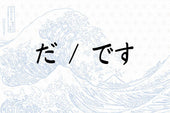
Understanding だ (da) and です (desu) in Japanese: Meaning and Usage
When learning Japanese, one of the first things you’ll come across is だ (da) and です (desu). These words don’t have a ...
-
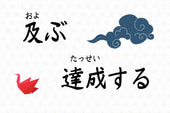
Difference Between 及ぶ (およぶ) and 達成する (たっせいする)
Both 及ぶ and 達成する can relate to "reaching" or "achieving" something, but they have distinct nuances and usage contexts...
-

JLPT N5 Study Guide: A Beginner's Roadmap to Acing the Test
If you’ve just started learning Japanese and are aiming to ace the JLPT N5, you’ll need a solid study guide to help y...
-

Beginner's Guide to Japanese Particles: Learn the Basics
TL;DR: Japanese particles are crucial for structuring sentences, acting like conjunctions or prepositions in English...
-

JLPT N5 Vocabulary List - All 748 Words You Need to Know
Vocabulary is the foundation of any language, and Japanese is no exception. The more you know, the better. Over time ...
-
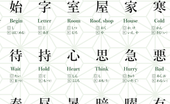
JLPT N4 Kanij List - All 176 Characters You Need To Know
After mastering the JLPT N5 kanji, you're ready to take your Japanese kanji game to the next level. JLPT N4. Let's go...
-
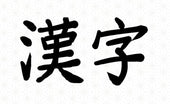
Kanji For Kanji - 漢字
Inception time. Which kanji compose the kanji of "kanji"? The kanji for "kanji" is actually pretty straightforward. I...
-

How to Memorize Katakana Easily: 9 Tips for Beginners
For those diving into Japanese, mastering hiragana and katakana is the first significant challenge. While hiragana o...
-
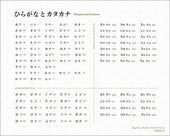
Complete Hiragana and Katakana Chart With All 112 Characters
The very first step for everybody who wants to learn Japanese is to study the hiragana and katakana chart (before lea...
-
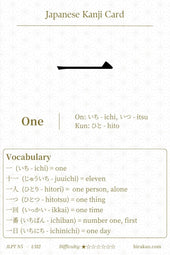
JLPT N5 Kanji: Kanji For One 一 (ichi)
Probably one the most simple kanji to remember, the kanji for 'one' is simply written '一'. Let's see its readings and...
-
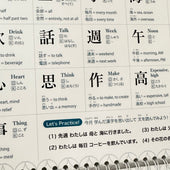
How Long Does It Take to Learn Kanji? A Beginner's Guide
Ask any Japanese student what's the scariest part of learning the language, and they'll say kanji. And they're righ...
-
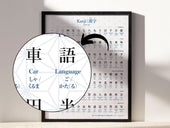
Is it Necessary to Learn Kanji? The Last Answer You'll Ever Need
Many beginners in Japanese wonder whether they should really learn kanji. I know this, because I also wondered when s...
-

How Long Does it Take to Learn Hiragana and Katakana?
As a beginner in Japanese, your first step is diving into the alphabets of Hiragana and Katakana. These are the build...
-

13 Best YouTube Channels to Learn Japanese, From Beginner to Intermediate
YouTube can be an incredible resource for learning Japanese. And best of all, it's free. So we've compiled a list of ...
-
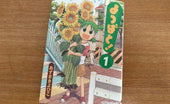
Top 10 Manga for Japanese Language Learners: From Beginners to Intermediates!
If you're learning Japanese, chances are you're interested in manga. So instead of reading texts about Tanaka-san s...
-
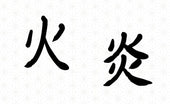
Kanji für „Feuer“ auf Japanisch: 火 oder 炎?
Willkommen zu unserer aufschlussreichen Erkundung des japanischen Kanji! Heute entfachen wir unser Verständnis ein...
-

Der vollständige Leitfaden zu Ländernamen auf Japanisch: Sagen Sie sie richtig und sprechen Sie sie richtig aus!
Egal, ob Sie eine Reise planen, Japanisch lernen oder einfach nur wissen möchten, wie verschiedene Länder in einer an...
-
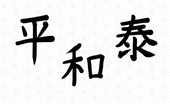
Kanji für Frieden: 平, 和, 泰 – Die Symbole der Harmonie
Sie fragen sich vielleicht, was die japanischen Symbole für „Frieden“ sind. In diesem Artikel tauchen wir tief in ...
-
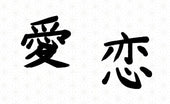
Kanji für „Liebe“: Wie und wann man 愛 und 恋 verwendet
Willkommen auf unserer Reise in die Welt des japanischen Kanji! Heute beschäftigen wir uns mit einem der herzerwär...
-
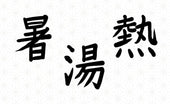
Kanji für „Hot“ auf Japanisch: 暑, 湯 und 熱 – Ein umfassender Leitfaden
Willkommen auf unserer Reise in die Welt des japanischen Kanji! Heute werden wir uns mit einem spannenden und wese...
-
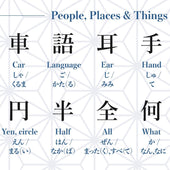
JLPT N5 Kanji-Liste – Alle 112 Zeichen, die Sie kennen müssen
Wenn Sie sich zum Ziel gesetzt haben, die JLPT N5-Prüfung zu bestehen, ist eines sicher: Ein fester Umgang mit Kanji ...

![この・その・あの・どの – Using ‘This / That / Which’ with Nouns in Japanese [JLPT N5]](http://hirakan.com/cdn/shop/articles/acd351ada3fe4b04ae86de788a3350b8.jpg?v=1766305268&width=170)
![これ・それ・あれ・どれ – Saying ‘This / That / Which One’ in Japanese [JLPT N5]](http://hirakan.com/cdn/shop/articles/this-that.jpg?v=1766305107&width=170)
![か~か – Expressing Choices like “A or B” in Japanese [JLPT N5]](http://hirakan.com/cdn/shop/articles/choices.jpg?v=1766304827&width=170)
![~から~まで – Saying “From A to B” in Japanese [JLPT N5]](http://hirakan.com/cdn/shop/articles/from-AtoB.jpg?v=1765093560&width=170)
![まで – Expressing “Until” and “Up To” in Japanese [JLPT N5]](http://hirakan.com/cdn/shop/articles/until-up-to.jpg?v=1765093405&width=170)
![から – Expressing “Because” and “From/Since” in Japanese [JLPT N5]](http://hirakan.com/cdn/shop/articles/because-from_since.jpg?v=1765093285&width=170)
![や – Listing Examples with “And, Among Others” in Japanese [JLPT N5]](http://hirakan.com/cdn/shop/articles/and.jpg?v=1765093138&width=170)
![か – Forming Questions and Saying “Or” in Japanese [JLPT N5]](http://hirakan.com/cdn/shop/articles/ka-questions.jpg?v=1763787134&width=170)
![も – Saying “Also” and “Too” in Japanese [JLPT N5]](http://hirakan.com/cdn/shop/articles/mo-also-too_99f908e6-78d0-4f82-8319-391ef42764bc.jpg?v=1763787251&width=170)
![と – Linking 'And', 'With', and Quotations in Japanese [JLPT N5]](http://hirakan.com/cdn/shop/articles/to-and-with-quotation.jpg?v=1763265110&width=170)
![で – Marking Where and How an Action Happens in Japanese [JLPT N5]](http://hirakan.com/cdn/shop/articles/de-where-how-action-happens.jpg?v=1763264973&width=170)
![へ – Marking Direction ‘Toward’ in Japanese [JLPT N5]](http://hirakan.com/cdn/shop/articles/he-marking-direction.jpg?v=1762667986&width=170)
![に – Marking Time, Destinations, and Recipients in Japanese [JLPT N5]](http://hirakan.com/cdn/shop/articles/ni-marking-destination.jpg?v=1762667846&width=170)
![の – Possession and Noun Linking in Japanese [JLPT N5]](http://hirakan.com/cdn/shop/articles/no-possession-and-noun-linking.jpg?v=1761961297&width=170)
![を – Marking the Direct Object in Japanese [JLPT N5]](http://hirakan.com/cdn/shop/articles/o-direct-object.jpg?v=1761960990&width=170)
![が – Marking the Subject ('Who/What') in Japanese [JLPT N5]](http://hirakan.com/cdn/shop/articles/ga-subject-marker_60f30f70-6ca5-47ee-9a00-3646195d7d3c.jpg?v=1761386355&width=170)
![じゃない・ではありません – Expressing 'Is/Was Not' in Japanese [JLPT N5]](http://hirakan.com/cdn/shop/articles/janai-dehaarimasen_2594963b-531e-4f4d-a9b0-361010e0a720.jpg?v=1760865884&width=170)
![だ・です/だった・でした – Saying ‘to be’ in Japanese [JLPT N5]](http://hirakan.com/cdn/shop/articles/da-desu-datta-deshita_58bbc732-53fd-48da-83c7-4e477e7cc0b2.jpg?v=1760864506&width=170)























